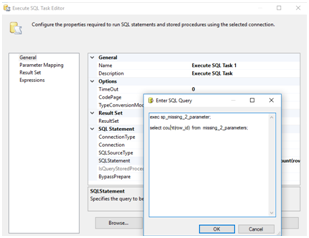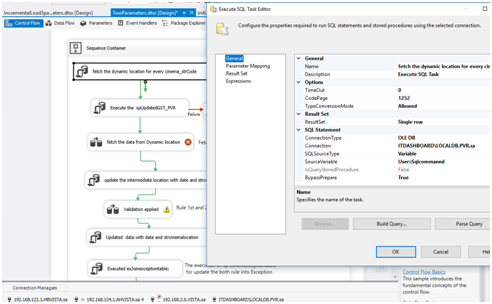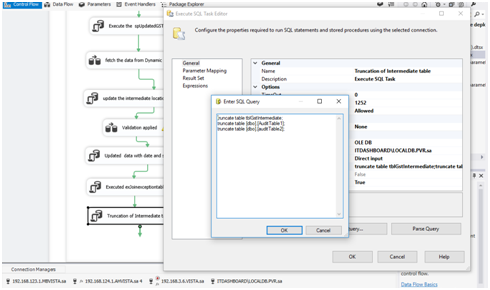The end client desires to upgrade the
sales reporting for its resources from the current MS Excel spreadsheets to an
online system.
The requirements of the end client were
as follows:
1 .) Consolidate
the data from multiple spreadsheets for
analysis over period in time.
2.) Provide
visibility for sales and expenses by route and truck .
Step 1: the ETL team mapped the spreadsheets onto a database(initially MS
Access) for easy data entry at the client main location for after trip and
before trip details. Attached are the details for the same (appendix a)
Design
of the audit report:
As a first step the ETL team replicated
the audit report for the end client in Powerbi. The purpose of replicating the
audit report was as follows:
1.) Check
whether the numbers are correct as per the data entry done for the end client
2.) Consolidate
all the audit numbers for the end client in one interactive framework.
The details of the replication of the
audit report are in appendix b.
Development of analytics and dashboards:
the ETL team identified four(4) key kpis
for analytic purposes.
·
Sales: date, truck and
route
·
Returned sales-returned
crates, returned full bottles, returned empty bottles: date, truck and route
·
Samples: date, truck
and route
·
Expenses: date, truck,
route and expense type.
The behavior of expense is as follows:
·
Aggregate by date
dimension and expense type
·
Semi aggregate by route
and truck master
·
Non aggregate by item
dimension
The behavior of sales is as follows:
·
Aggregate by date
dimension
·
Aggregate by truck and
route master
·
Non aggregate by
expense type
·
Aggregate by item
entities.
In case of expenses analysis the
analytics to be developed were to be grouped by expense type(that does not fall
in direct hierarchy with route and truck hierarchies). Hence the calculated
measures need to be fixed at each level of analysis by expense type( for route
truck and overall analysis).
Accordingly the etl team developed the
following kpis for the expense analytics:
Expense(fixed overall):
All expense: CALCULATE(SUM(after_trip_allocation[expense]),ALL(after_trip_allocation),after_trip_allocation[type_of_expense_id]>0)
NOTE: The type of expense id was
stipulated to be more than 0 since without the expense id expense aggregate
would not make sense.
Expense across route id and expense nature:the given measures
fixes the total expense
EXPENSE_ACROSS_ROUTE_EXPENSETYPE
= CALCULATE(SUM(after_trip_allocation[expense]),ALLEXCEPT(after_trip_allocation,after_trip_allocation[route_id],'type
of expense'[expense_nature]), after_trip_allocation[type_of_expense_id]>0)
Percentage calculation
for route:
PERCENT_ROUTE =
(after_trip_allocation[EXPENSE_ACROSS_ROUTE_EXPENSETYPE]/after_trip_allocation[expense_excl_nature])*100
Expense across truck id
and expense nature:
EXPENSE_ACROSS_TRUCK_EXPENSE_NATURE
= CALCULATE(SUM(after_trip_allocation[expense]),ALLEXCEPT(after_trip_allocation,Truck_master[Truck_ID],'type
of expense'[expense_nature]),after_trip_allocation[type_of_expense_id]>0)
Percent expense along
the truck route is defined as follows:
PERCENT_TRUCK = (after_trip_allocation[EXPENSE_ACROSS_TRUCK_EXPENSE_NATURE]/after_trip_allocation[expense_excl_nature])*100
Attached is the dashboard for the expense analysis:
Calculation of sold bottles:
Sold bottles is the
difference of quantity loaded,return bottles and sample bottles.
Attached is the snapshot
for the sold bottles
sold_bottles =
SUM('Before_trip_allocation'[quantity_loaded]) -
SUM('after_trip_allocation_item'[Returned_bottles])-CALCULATE(sum(after_trip_allocation_item[returned_full_bottles]),after_trip_allocation_item[sample_flag]="'sample'")
Sold bottles are
calculated on the basis of:
·
Vehicle no.
·
Route description
·
Date dimension
·
Item dimension(brand,volume and holding type)
Attached is the
dashboard of the sold bottles:
Vehicle no and the route
description is the slicer .we can
analyzed the sold bottles for the particular
vehicle and route.
Calculation of sample bottles
Sample bottles is
extracted from the sample flag.
Attached is the snapshot
for the sold bottles
Sample =
CALCULATE(sum(after_trip_allocation_item[returned_full_bottles]),after_trip_allocation_item[sample_flag]="'sample'")
Sample bottles are
calculated on the basis of:
·
Vehicle no.
·
Route description
·
Date dimension
·
Item dimension(brand,volume and holding type)
Attached is the
dashboard of the sample bottles:
Calculation of return bottles:
Return bottles is
extracted from the sample flag.
Attached is the snapshot
for the sold bottles
Returned_bottles = CALCULATE(sum(after_trip_allocation_item[returned_full_bottles]),after_trip_allocation_item[sample_flag]="'returned'")
Return bottles are
calculated on the basis of:
·
Vehicle no.
·
Route description
·
Date dimension
·
Item dimension(brand,volume and holding type)
Attached is the
dashboard of the return bottles:
Appendix
A
LIQUOR
COMPANY MOBILITY APP
The given implementation has been done
to automate the field sales collection data for Liquor Company.
As a first step, the ETL team has
deployed the MS Access database on the client end for data capture of before
and after truck load. That is the ETL team has devised a system wherein it
captures the data when the truck is loaded by various SKUs. Also the end client
inputs the data after the truck has completed its journey.
The benefit to the end client is that
the ms excel spreadsheets shall be replaced by database and consolidated
reporting shall be available to the end client.
Access
Implementation
The end client desired to have a set of reports using PowerBI and database is created in MS Access using the following features:
·
Calculate the crates
loaded on the basis of driver name,areaname,sales person.
·
Calculate the Daily
routine sales and commission report on the basis of brand ,volume and
holding types.
·
Calculate the total
bottles sold after the trip.
Database model for Access interface is
as follows:( the data model was developed by reverse engineering the client
spreadsheets)
Attached is the explanation of the
database model:
Truck Master: The truck master entails all the master data for the
truck.It includes the vehicle no.,driver no.,helper,sales person of the truck.
Route Master: The route master entails all the
master data for the route.The route master
has one to many relation with the truck
master.That is a truck can use the various route to travel or will have
the same route on multiple dates. .It includes all the information of route
i.e. when the journey started ,what was
the meter reading and how many crates
are loaded.
Before trip allocation:
Before trip allocation entails all the information of the item before the
journey was started i.e. how much quantity was loaded of which brand,volume and
holding type.which type of load was it,either it is for “sales” ,”promotion”or
”sample”.
After trip
allocation:it entails all the information of after trip of the truck on the
given route.i.e how any full bottles,emptybottles,emptycrates,breakage bottles
are returned,how much fuel was consumed and the expense details .
After trip allocation
item: it entails all the information of after trip.i.e how any full
bottles,emptybottles,emptycrates,breakage bottles are returned,which types of
material was sold “sample”,”promotion”
or “sold”.
The database is created
in MS Access.There are two buttons before trip and after trip.
Attached is the
snapshot :
Before trip allocation
contains all the details of the truck ,when the journey was started and how
much quantity was loaded of which brand ,what is the volume and the holding
types.
After trip
allocation:the after trip form contain the
after trip allocation detail and expense detail on the basis of vehicle
no. and area name.
Attached is the
snapshot:
After trip allocation
form contains the duration of journey and the description of the sample flag
i.e either the item returned was
“return” or “sample” on the basis of brand, volume and holding types.
Expense detail: This form contains
the expense details of the truck.
Appendix B
Attached
is the explanation for the dashboard developed for replicating the audit
report.
The above portion has been mapped in PowerBI as
follows
Area name and Vehicle no:
These 2 have been assumed to be filter parameter as follows:
Vehicle no. and area
name have been used as slicers for the given
dashboards.
DAX
function:The sample and returned bottles are
calculate by using the dax
functionality.
Attached is the
snapshot:
This is the aggregate
function.we use the DAX functionality for the calculation of the returned
bottles
For
the same the etl team generated an aggregate for ‘after_trip_allocation’
Attached
is the snapshot
Cross filter sample:
In case interested in converting spreadsheets to data model, please contact the following:
Name: Apoorv Chaturvedi
Phone: +91-8802466356
email: apoorv@mnnbi.com
Blog prepared by:
Pinky Singh: https://www.linkedin.com/in/pinky-singh-a77a4a180/














































